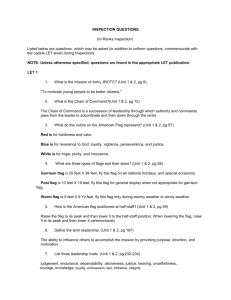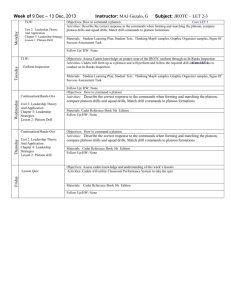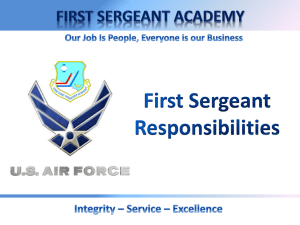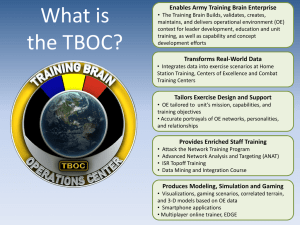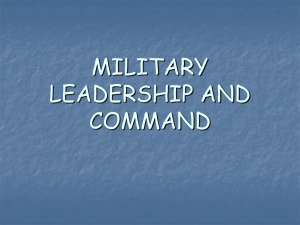Promotion Board Study Guide
advertisement
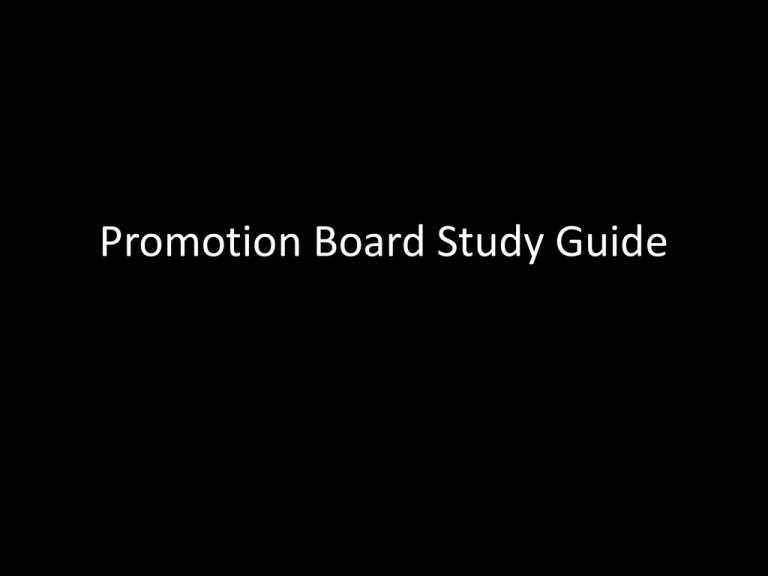
Promotion Board Study Guide Leadership • The Ability to influence, lead, or guide others so as to accomplish a mission in a manner desired Factors of Leadership • The leader, the led, the communication, and the situation Leadership Traits (14) • • • • Bearing Courage Dependability Decisiveness • • • • Endurance Enthusiasm Integrity Initiative • • • • Judgment Justice Knowledge Loyalty • Selflessness • Tact Principles of Leadership (11) • • • • • • • • • • • Be Technically and tactfully proficient Build the team Develop a sense of responsibility in your subordinates Ensure the task is understood, supervised, and accomplished Employ your cadet in accordance to their capabilities Keep your subordinates informed Know yourself and seek self-improvement Make sound and timely decisions Possess professional characteristic traits Seek responsibility and take responsibility for your actions Set the example Three Styles of Leadership • Directing • Delegating • Participating Professional Characteristic Traits Candor Competence Commitment Courage Integrity The 14 Principles of Motivation • • • • • • • • • • • • • • Make the need of subordinates coincide with the unit task and missions Reward individual and team behavior that supports unit task and mission Council subordinates who behave in a way that is counter to unit task, mission, and standards Set the example in all things Develop morale and esprit within the unit Give subordinates tough problems, and challenge them to wrestle with them Have subordinate participate in planning of upcoming events Alleviate causes of the personal concerns of subordinates so they can concentrate on their jobs Ensure that subordinates are properly cared for and have the tools they need to succeed Keep subordinates informed about missions and standards Use positive peer pressure to work for you, the leader, and the unit Avoid using statistics as a major method of evaluating and motivating subordinates. Make the jobs of subordinates as challenging, exciting, and meaningful as possible Do not tolerate any form of prejudicial talk or behavior • The 4 Influence Approaches – Controlling- Exerting pressure to persuade someone to your view – Relinquishing- giving up influence and reducing ones contribution to the situation – Developmental- sharing opinions or facts, used for a consensus – Defensive- withdrawing from the situation and allowing the team to figure it out • The 5 Sources of Power – Reward Power- Complying with wishes to get something of value in return – Coercive Power- fear that negative results will occur if one does not apply – Legitimate Power- authority given to the person in the position with the hierarchy – Referent Power- power based on admiration – Expert Power- Power resulting from specific expertise, knowledge, or special skill • Command Philosophy (8) •Teamwork •Leadership •Training •Caring •Professionalism •Appearance •Safety •Be a good student, and do it well • Army Values (7) – Loyalty• bear truth faith and allegiance to the US constitution, the Army, your unit, and other soldiers – Duty• fulfill your obligations – Respect• treat people as they should be treated – Selfless Service• put the welfare of the nation, the Army and your subordinates before your own – Honor• live up to all the Army values – Integrity• do what is right; legally and morally – Personal Courage• face danger, fear, or adversity (physical or moral) • The Three A’s – Attitude: Be positive – Actions: Be responsible for them – Achievements: Enjoy your successes, as well as those of your fellow students • The Three S’s – Safety: It’s an attitude – Standards: Set high and enforce – Success: Train to it Duties • First Sergeant – Responsible to the company commander for the accuracy of the company muster – Assist the company commander in conducting inspections, supervising training, and company administration – Performs other duties as required • Platoon Leader – Responsible to the company commander for the conduct, appearance, and state of training within their platoon – Exercises authority by personal example, instruction, and close supervision – Performs other duties as required • Platoon Sergeant – – – – Assist the platoon leader in the execution of their duties Ensures the accuracy of the squad leaders report Exercises authority by personal example, instruction, and close supervision Performs other duties as required • NCOs – Responsible for the training, discipline, and welfare of their subordinates • Cadet Officers and NCOs – Are responsible to the SAI for the appearance discipline, and efficiency of their unit Drill • What is meant by the term drill – Movement by which a unit of individuals are moved in a orderly manner from one formation to another and one place to another • Purpose of Drill – Enable a commander to move his units from one place to another in a orderly manner – Aids in the disciplinary training by installing habits of precision and response to leaders orders – Provides means, through ceremony, of enhancing morale of troops, develop a sprit of cohesion, and presenting traditional, interesting, and well executed military parades – Provide for the development of all soldiers in the practice of commanding troops • Drill and Ceremonies – FM 3-21.5 or FM22-5 • The text that covers army regulations for JROTC program organization administration, operation, training, and support is AR 145-2 (known as Cadet Command Regulation 145-2) Drill Commands • Two-part commands-preparatory and command of execution ( can have two preparatory commands ) – Preparatory Command- states movement to be carried out and prepares the cadet to take action – Command of Execution- tells when the command is to be carried out • Combined Command- has no inflection or break in the voice (Fall In, At Ease, Rest) • Supplementary Commands- commands that add to the command. Usually given by a subordinate leader that reinforce and compliment a commanders preparatory command to insure proper understanding and execution of movement (File from the right, column____) • Directive Command- commands that usually hand over command to the individual units ( take control of your platoons and march them to the) • Drill command – Is an oral order of the commander or leader Company Formations • When the first sergeant is up front, the platoon sergeants are in front of the platoons, and the platoon sergeants should be six steps from the first sergeant and two and a half steps, plus the number that is equal to half the number of cadets in first squad (which should be the largest) that way the company is centered on the first sergeant. At this time the platoon leaders are one step behind the platoon and centered. The company commander is three steps behind the platoons. The squad leaders should be three steps away from the platoon sergeant , and the number of steps equal to half the number of cadets in the largest squad out. This would make them nine steps from the first sergeant Company Formations • When the company commander comes foreword, he goes three steps past the first sergeant. When he calls post, the platoon sergeants march to their right and go around the platoon while the platoon leaders march to their right past the platoon, three steps past the platoon sergeants last position, making him sic steps from the platoon and six steps from the company commander, thus making the company commander twelve steps from the company. The platoon sergeants are one step behind the company. The first sergeant is three steps behind the platoons when the company commander is commanding the company Formation Questions • Platoon – Two formations• line and column – Line• also called rank or element (essentially squads), is a single line of cadets side by side – Column• Also called file, is a single line of cadets one behind the other • Platoon leader – A platoon leader is always either six steps from the front center of the platoon, six steps from the left side of a flank (centered), or one step, centered, in front of the platoon in column formation. A platoon leader is three steps from the first sergeant and six steps from the company commander. The formation is always 2 steps from the last person in first squad to the company commander/ first sergeant and twelve steps from the company commander or nine steps from the first sergeant. • If you have a platoon in formation, and are at ease when an officer approaches, you should – Call the platoon to attention and salute the officer • What is accomplished by practicing dismounted • Attention to detail drill? •Teamwork •Confidence •Pride alertness • Esprit de corps • Discipline Rates of march for Quick Time 120 steps per minute Rates of march for Double Time 180 steps per minute Muster formation A ceremonial company formation to call role or determine accountability of Personnel The only person in a formation that is never out of step is the • Platoon guide DEFINE o o o o o • Cadence •A uniform step and rhythm in marching Rank •A single line of men side by side (squad) File •A single line of men on behind the other Interval •Lateral space between elements Distance •Space between elements in a column or file length of a marching step is The – 30 inches • The length of half step or right or left step is – 15 inches • The length of an arm swing – nine to the front and six to the rear (inches) • A marching step is measured – Heel to heel Commands • To change direction while marching, the preparatory commands are given – On the same foot as the direction desired • The only stationary command that will allow a cadet to talk while in formation is – Rest • The command given while marching that will allow a cadet to talk while in formation is – Route Step March • When the command eyes right is given – The head is turned forty-five degrees except for the right file, which looks forward and renders a salute • To avoid an obstacle while marching, the proper command is – Incline around ____ • When the command cover is given – All the elements should dress directly behind each other • The two commands that can be given to bring a unit or other individuals to attention are – Fall in, and Attention Commands • The command given to revoke an improperly given command is – As you were • Two rest movements given during a march – At Ease March and Route Step March • Five rests executed from halt – – – – – At Ease Stand At Ease Rest Parade Rest Halt • At route step march, the command that brings the unit back to attention is – Quick Time March • From halt the only movement that starts with the right foot is – Right Step March • During Route Step, a cadet may – Talk to the person near them – Fall out of step • During At Ease March the cadet may – Only fall out of step, no talking or other movement is allowed Knowledge AFI • pts for each AFI inspection – Cadet Staff Briefing • 100 – Curriculum Knowledge • 100 – In-Rank Inspection • 65 – Cadet Attendance/Participation • 50 – Cadet Supply Room Inspection • 50 – Records and Administration • 50 – Training and Management • 50 – Public Affairs • 50 – Drill and Ceremony • 50 – Color Guard • 35 – Total • 600 The name of the Army song is The Army goes rolling along Boron Von Stuben Was a Prussian officer who fought with the colonies and initiated the blue book which later became the FM 22-5 for Drill and Ceremony Official date when the US Army was founded June 1775 When to salute When you hear the National Anthem or Hail to the Chief while outdoors in uniform When passing by the National Colors When reporting When the command present arms is given When casing and uncasing the colors When not to salute When in public areas or on public transportation When indoors (except when reporting) When inappropriate or physically impractical When one or both of the parties are in civilian attire Knowledge • Battalion Staff – – – – – • S1- Administration/Personnel Officer S2/S3- Intelligence/ Operations and Training Officer S4- Logistics Officer S5- Public Affairs Officer S6- Information Systems Officer Condition for enrollment is in accordance with – AR 145-2 • Retention is now according to – Circle of Standards • Circle of Standards •Inspection •Drill and Ceremonies •Attendance •JROTC exams/projects • •JROTC grade •JROTC GPA •Discipline •Promotion Boards Army JROTC Goals (9) •Promote citizenship •Develop Leadership •Communicate effectively •Improve physical fitness •Provide initiative to live a drug free life •Strengthen self-motivation •Provide historical perspective of military services •Work as a team member •Graduate from high school Knowledge • JROTC Core Abilities – – – – Build your capacity for life long learning Communicate using verbal, nonverbal and written techniques Take responsibility for your actions and choices Do your share as a good citizen in your school, community, country, and the world – Treat self and others with respect – Apply Critical thinking and techniques • Flags – Storm • Inclement weather-5x9 feet – Post • When garrison flag is not up- 10x19 ft – Garrison • Holidays and special occasions- 20x38 ft • 3 Colors and Representation – Red- hardiness and valor – White- innocence and purity – Blue- perseverance, vigilance, and justice • The American flag can never render a salute unless a ship formally recognized as an ally of a US ship sends a salute, the ship must return it Knowledge • 3 terms used for flags – Standard • for mounted troop – Colors • Dismounted troops – Ensigns • On ships • When a president or past president of the US dies – The flag is flown at half-mast for 30 days • A flag can be flow upside down ONLY to signal distress or emergency • An individual will hold a salute for six steps when passing the national flag or when the colors pass by • The difference between the national colors and the flag is – The national colors are trimmed on three sides with a golden-yellow fringe • A guidon is – A small swallow tailed flag normally carried by a troop, company or battery • On Memorial Day, the flag – Is flown at half mast until noon and then raised to full stall • The US flag has – 50 starts, and 13 stripes, 7 are red and 6 are white Knowledge • The ball on the top of the flag, called the truk , represents – The shot heard round the world fired April, 19, 1775 at Lexington, Massachusetts ( the start of the American revolution) • The best way to destroy an unserviceable flag is – To cut the stars from the stripes and incinerate them together in private • The Reveille is played for – 20 seconds • When the US flag is displayed with the other flags in a row, it is displayed – On the far right of the line, or to the left of the observers • The name of the National Anthem is – The Star Spangled Banner and was written by Francis Scott Key • The US flag represents – The living country and represents a living thing

